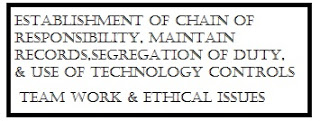Types of Internal Control for Small & Medium Business/the Checklist – This defines the types and forms of procedures, measurements, approaches and scalar chain in operation in the internal control system of a small or medium scale business outfits. It defines also the applications, objectives, achievements and weaknesses of these measures.
In fact, it encompasses internal control procedures in accounting and auditing, everyday administrative life of an organisation, types of controls as preventive, detective and corrective. Do you desire to know more about the Types of Internal Controls for Small & Medium Business/the Checklist, just read on.
Are you the one I’m talking to?
If you have not been applying these in your organisation you are welcome. If you have been finding it difficult to implement these principles in your organisation, this article is for you. In my years of professional practices, I have come across much of this situation. That is why I’m writing this. It’s my belief that you will take what you have here seriously, and to apply them in your organisations.
An unpleasant fact of business is that some customers shoplift, some vendors and suppliers overcharge and short-count on deliveries, some employees embezzle or steal assets, and some managers commit fraud against the business or take personal advantage of their position of authority in the business.
The scope of Internal Control.
Internal controls are procedural measures an organization adopts in its management to perform their activities ethically and honestly so as to secure its assets and property. These measures include physical security barriers, access restriction, locks and surveillance of equipment.
They are procedures and measure adopted to protect company records ( Accounting and administrative data ), cash and other tangible and intangible assets.
Types of Internal Controls for Small & Medium Business/the Checklist
Internal controls are developed with the aim of providing management reasonable assurance that an organizations business objectives will be achieved. It’s particularly designed to prevent risks, detect risks, and take corrective actions.
These ethical principles emanates from the top management to the lowest member of the organisation. It’s an inclusive practice that involves the entire stakeholders of the organisation including staff, customers, suppliers, government, and the society (environment) at large.
This is the way you must see and aspire to apply the internal control policies of your organisation.
Measures for Controls:
What forms of control do you need to put in place in your organization?
There are three kinds of internal controls you can have in place. These are detective controls, corrective controls, and preventive controls.
The detective controls are regular management functions that you need to put in place as regards safeguarding your company assets. This type of control is there to alert you when things are going wrong. It requires you to take meaningful actions from time to time. Remember that if you don’t take proactive actions, this may not give you what you want.
Corrective controls are the sets of controls that you must put in place to make right whatever might have gone wrong. Monitoring activities are classed under this kind of controls.
Performance analysis may also reveal variances that are not normal. Again good Budgetary control will also help you in identifying deviations in plans.
Having a reliable backup of data as part of business continuity plan is a very good example of corrective controls.
Preventive controls are the most robust and highly recommended type of controls. Your management team must be encouraged to promote this as part of the overall corporate governance.
Types of Internal Controls for Small & Medium Business/the Checklist
What objectives do you want to achieve by all of these?
The broad objective of control is to ensure that assets of a company are safeguarded. This is to ensure that the strategic goal of an organization are achieved. You can apply and achieve internal controls objectives to any area of business and to any kind of business.
On the Types of Internal Controls for Small & Medium Business/the Checklist, the following are some examples of control objectives that you must strive for:
- Accuracy, completeness and timeliness of data – These three variables must work together – if you neglect one of them, your operation’s report may not be very valid.
- Upholding positive and effective cash management. – In addition to other current assets management.
- Confidentiality of customers data – you must not erode the trust on you. Always sustain your goodwill.
- Authorization and authentication of processes – every arm of the organization must adhere to these.
- Safeguarding of both IT and non IT resources – access restriction is very important.
- Achieving efficiency and effectiveness in implementing operations – this is the end product of the whole exercise.
- Promotion of reliability of processes – the system must be sustained, that is what will make it reliable.
- Complying with corporate policies and legal requirements – it’s very essential that you operate within the ambit of the law of the land.
- Achievement of high level of employees motivation – the entire exercise should be carried out in such a manner that all members of staff love what they are doing
- Achievement of good change management process – change processes must be well managed to avoid disillusionment on some members of the organization.
- The control measures flows from top to bottom.
A small medium business particularly is a natural target for fraudulent schemes, scams, employee embezzlement, pilferage, worker crime, and theft.
How do you go about achieving these?
You have to determine to apply internal control measures in every aspect of your operations. Therefore, there must be Operational controls. These are sets of laid down rules, principles, procedures, guidelines and ways of running the day-to-day activities of your organization.
Such controls you must put in place to ensure that employees do their work according to their job description/schedule. The application of such procedures in a manufacturing factory plant is an example.
Don’t neglect the administrative controls. Most challenges you may face in the organization may be emanating from the administrative departments. Therefore, you must put in place such administrative procedures, checks and balances that will enhance the effective and efficient running of administrative works.
Types of Internal Controls for Small & Medium Business/the Checklist
The next place you must put your feed down on internal control measures is in the Accounting departments. Many of you think this is the only place controls are necessary, but you can see that it’s the last place to look at in terms of control measures.
Not withstanding that Accounting is a regulated professional job, the controls are there to make sure that the accounting information system is working according to plan. The accounting controls are there to ensure the security of accounting systems, completeness, and accuracy, and timelines of accounting data, and the validity of any input that goes into the system.
How would you manage the non-responding aspects?
These are the loopholes and they pose as the weakness of this good exercise.
The weakest link in any internal control is the human link. A well designed robust internal control system may not be effective if the employees work against it. That is why you must try to motivate and carry every one along.
Another common weakness of internal control which you must avoid is the lack of proper segregation of duty. These measures can easily be circumvented when there is no properly implemented segregation of duties. Internal control is nothing without good separation of duties.
Types of Internal Controls for Small & Medium Business/the Checklist
Again is the lack of positive organizational structure. The chain of command – vertical and horizontal – must be in place and well defined. There has to be an enabling control environment for results to be achieved.
“Internal controls are developed with the aim of providing management reasonable assurance that an organization’s business objectives will be achieved.”
I know that you fee good now, having gone through this article. You now know what to do and how. If you continue finding it difficult to implement these principles in your organisation let me know. I will help you pattern a workable internal control procedures that will enable you achieve your organization’s goal and objective.
Types of Internal Controls for Small & Medium Business/the Checklist
Try your best to like us on our Facebook page and by that guarantee you receive regular update on business tips.
Considering the Types of Internal Controls for Small & Medium Business/the Checklist, do you desire articles on Business Tips, Business plan and feasibility study, C.A.C. Incorporation, Accounting and Auditing, Tax Management, Mining, travels and tours, feasibility analysis, real estate management, then visit here. Contact cfmclimited@gmail.com and +234 8034347851
Deacon Anekperechi Nworgu, a seasoned economist who transitioned into a chartered accountant, auditor, tax practitioner, and business consultant, brings with him a wealth of industry expertise spanning over 37 years.





